Vittorio Degli-Esposti
editors
Towards Generative Ray Path Sampling for Faster Point-to-Point Ray Tracing
Oct 31, 2024Abstract:Radio propagation modeling is essential in telecommunication research, as radio channels result from complex interactions with environmental objects. Recently, Machine Learning has been attracting attention as a potential alternative to computationally demanding tools, like Ray Tracing, which can model these interactions in detail. However, existing Machine Learning approaches often attempt to learn directly specific channel characteristics, such as the coverage map, making them highly specific to the frequency and material properties and unable to fully capture the underlying propagation mechanisms. Hence, Ray Tracing, particularly the Point-to-Point variant, remains popular to accurately identify all possible paths between transmitter and receiver nodes. Still, path identification is computationally intensive because the number of paths to be tested grows exponentially while only a small fraction is valid. In this paper, we propose a Machine Learning-aided Ray Tracing approach to efficiently sample potential ray paths, significantly reducing the computational load while maintaining high accuracy. Our model dynamically learns to prioritize potentially valid paths among all possible paths and scales linearly with scene complexity. Unlike recent alternatives, our approach is invariant with translation, scaling, or rotation of the geometry, and avoids dependency on specific environment characteristics.
White Paper on Radio Channel Modeling and Prediction to Support Future Environment-aware Wireless Communication Systems
Sep 29, 2023Abstract:COST INTERACT working group (WG)1 aims at increasing the theoretical and experimental understanding of radio propagation and channels in environments of interest and at deriving models for design, simulation, planning and operation of future wireless systems. Wide frequency ranges from sub-GHz to terahertz (THz), potentially high mobility, diverse and highly cluttered environments, dense networks, massive antenna systems, and the use of intelligent surfaces, are some of the challenges for radio channel measurements and modeling for next generation systems. As indicated in [1], with increased number of use cases (e.g., those identified by one6G [2] and shown in Fig. 1) to be supported and a larger number of frequency bands, a paradigm shift in channel measurements and modeling will be required. To address the particular challenges that come with such a paradigm shift, WG1 started the work on relevant topics, ranging from channel sounder design, metrology and measurement methodologies, measurements, modeling, and systematic dataset collection and analysis. In addition to the core activities of WG1, based on the strong interest of the participants, two sub-working groups (subWGs) have been initiated as part of WG1: i) subWG1.1 on millimeter-wave (mmWave) and THz sounding (subWG THz) and ii) subWG1.2 on propagation aspects related to reconfigurable intelligent surfaces (RIS) (subWG RIS). This white paper has two main goals: i) it summarizes the state-of-theart in radio channel measurement and modeling and the key challenges that the scientific community will have to face over the next years to support the development of 6G networks, as identified by WG1 and its subWGs; and ii) it charts the main directions for the work of WG1 and subWGs for the remainder of COST INTERACT duration (i.e., until October 2025).
A Study on mm-wave Propagation in and around Buildings
Oct 13, 2022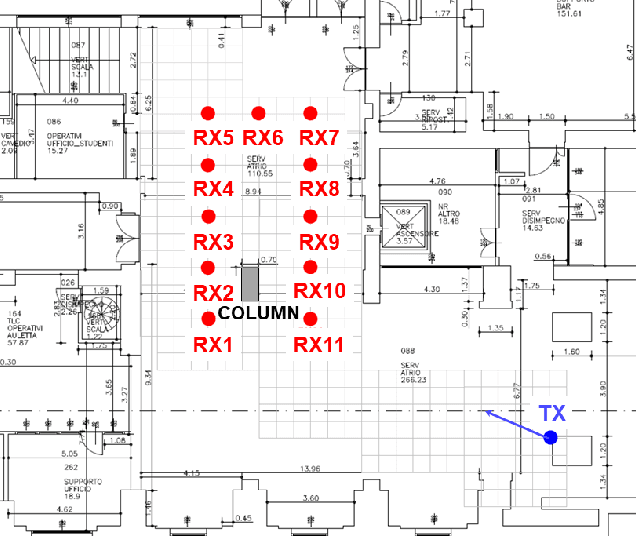
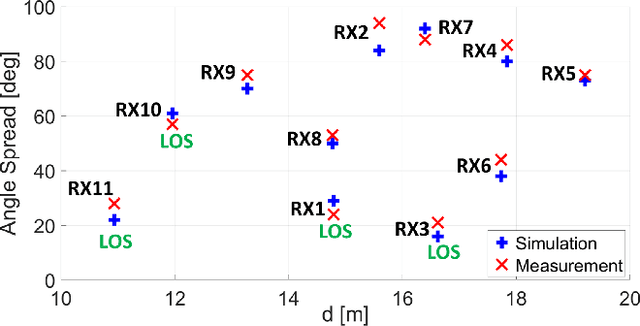
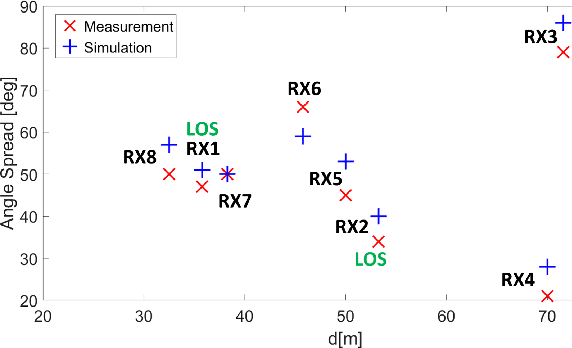
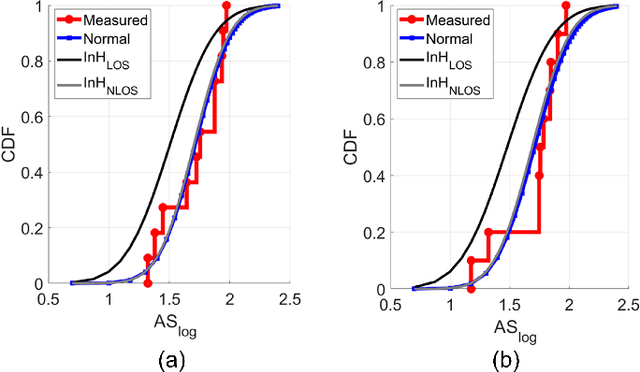
Abstract:mm-waves are envisaged as key enabler for 5G and 6G wireless communications, thanks to the wider bandwidth and to the possibility of implementing large-scale antenna arrays and new advanced transmission techniques, such as massive MIMO and beamforming, that can take advantage of the multidimensional properties of the wireless channel. In order to further study the mm-wave wireless channel, where propagation shows different characteristics compared to the sub-6 GHz band, a joint measurement and simulation campaigns in indoor and outdoor microcellular environments has been carried out. The investigation highlights that the traditional assumption that mm-wave NLoS propagation is problematic is not true since significant reflections, scattering and even transmission mechanisms provide good NLoS coverage in most indoor and outdoor scenarios. This also reflects in the limited angle-spread differences between LoS and NLoS locations in some cases. Finally, the contribution of different propagation mechanisms (reflection, diffraction, scattering and combination of them) to the received power is analyzed in the paper with the help of ray tracing simulations.
On Dynamic Ray Tracing and Anticipative Channel Prediction for Dynamic Environments
Apr 30, 2022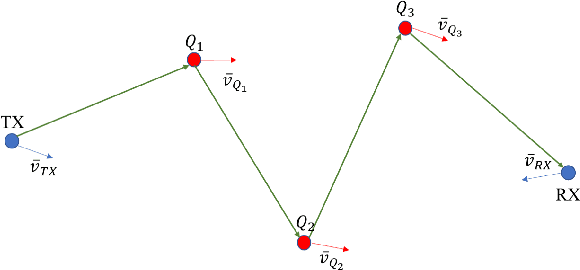
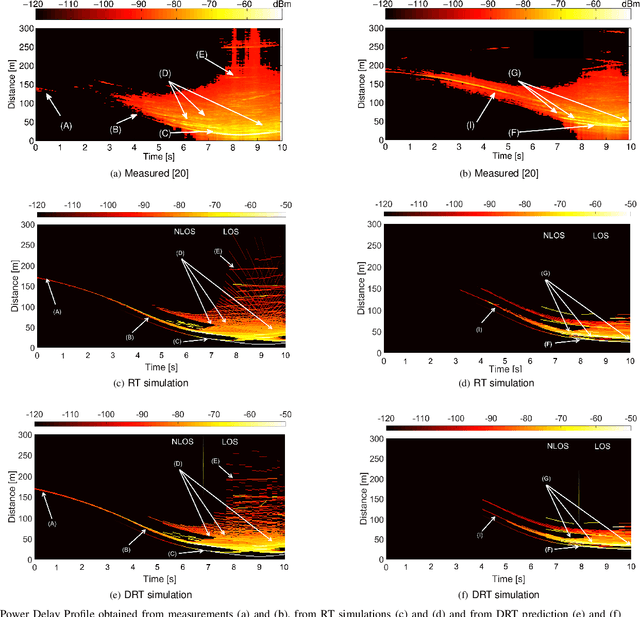

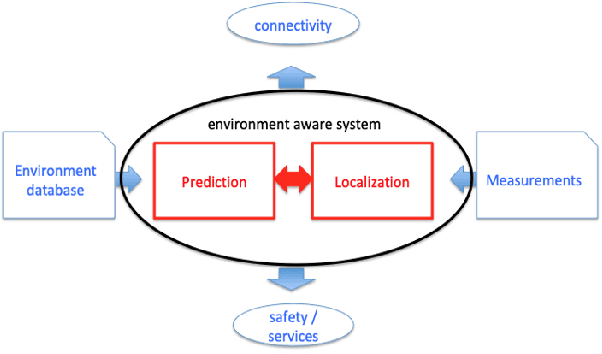
Abstract:Ray tracing algorithms, that can simulate multipath radio propagation in presence of geometric obstacles such as buildings, objects or vehicles, are becoming quite popular, due to the increasing availability of digital environment databases and high-performance computation platforms, such as multicore computers and cloud computing services. When objects or vehicles are moving, which is the case of industrial or vehicular environments, multiple successive representations of the environment ("snapshots") and multiple ray tracing runs are often necessary, which require a great human effort and a great deal of computation resources. Recently, the Dynamic Ray Tracing (DRT) approach has been proposed to predict the multipath evolution within a given time lapse on the base of the current multipath geometry, assuming constant speeds and/or accelerations for moving objects, using analytical extrapolation formulas. This is done without re-running a full ray tracing for every "snapshot" of the environment, therefore with a great computation time saving. When DRT is embedded in a mobile radio system and used in real-time, ahead-of-time (or anticipative) field prediction is possible that opens the way to interesting applications. In the present work, a full-3D DRT algorithm is presented that allows to account for multiple reflections, edge diffraction and diffuse scattering for the general case where moving objects can translate and rotate. For the purpose of validation, the model is first applied to some ideal cases and then to realistic cases where results are compared with conventional ray tracing simulation and measurements available in the literature.
Characterizing the UAV-to-Machine UWB Radio Channel in Smart Factories
Apr 19, 2021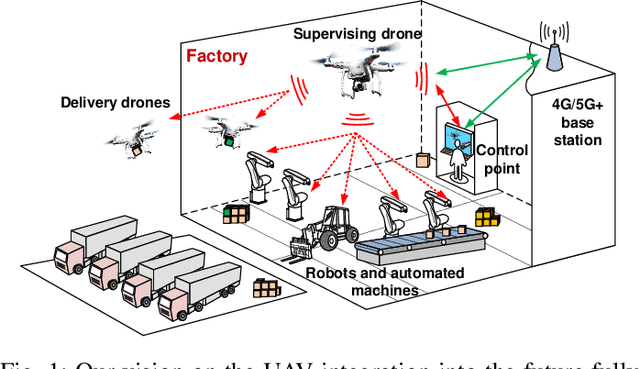
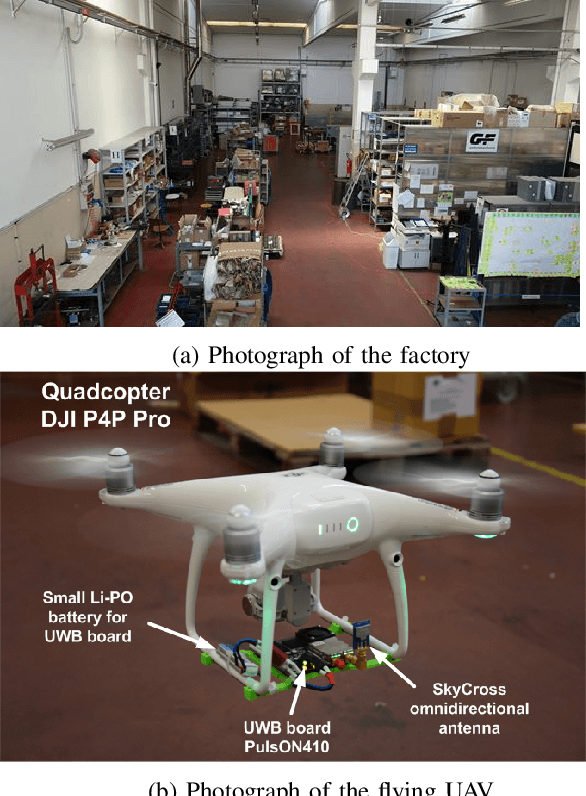
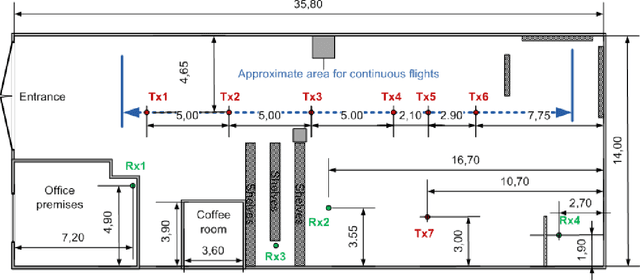
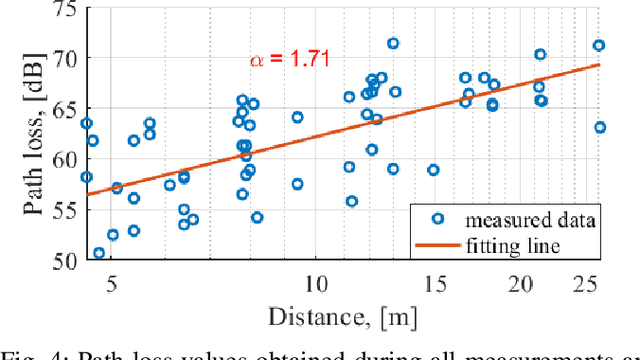
Abstract:In this work, the results of Ultra-Wideband air-to-ground measurements carried out in a real-world factory environment are presented and discussed. With intelligent in-dustrial deployments in mind, we envision a scenario where the Unmanned Aerial Vehicle can be used as a supplementary tool for factory operation, optimization and control. Measurements address narrow band and wide band characterization of the wireless radio channel, and can be used for link budget calculation, interference studies and time dispersion assessment in real factories, without the usual limitation for both radio terminals to be close to ground. The measurements are performed at different locations and different heights over the 3.1-5.3 GHz band. Some fundamental propagation parameters values are determined vs. distance, height and propagation conditions. The measurements are complemented with, and compared to, conventional ground-to-ground measurements with the same setup. The conducted measurement campaign gives an insight for realizing wireless applications in smart connected factories, including UAV-assisted applications.
Empirical Characterization of Air-to-ground Propagation at mm-Wave Frequencies in Dense Urban Environment
Jan 04, 2021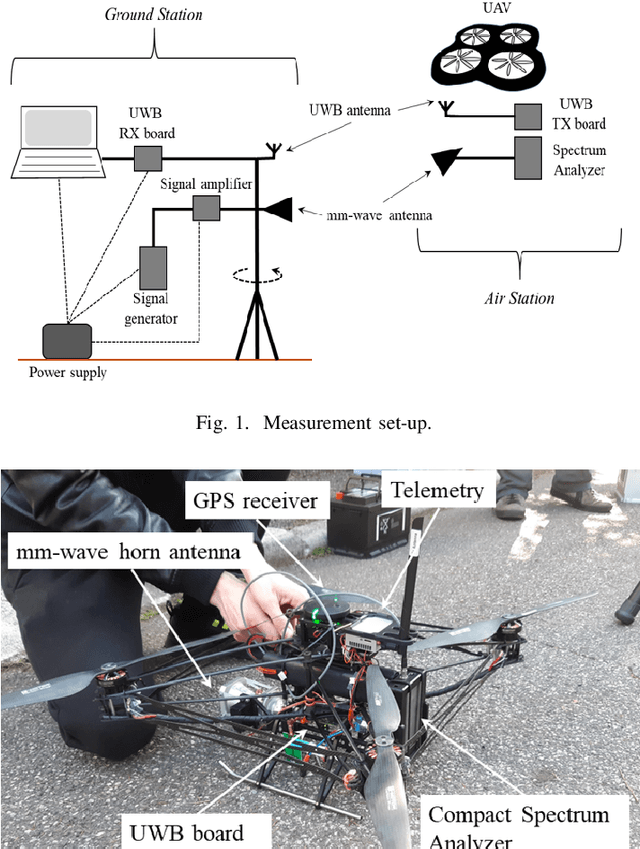
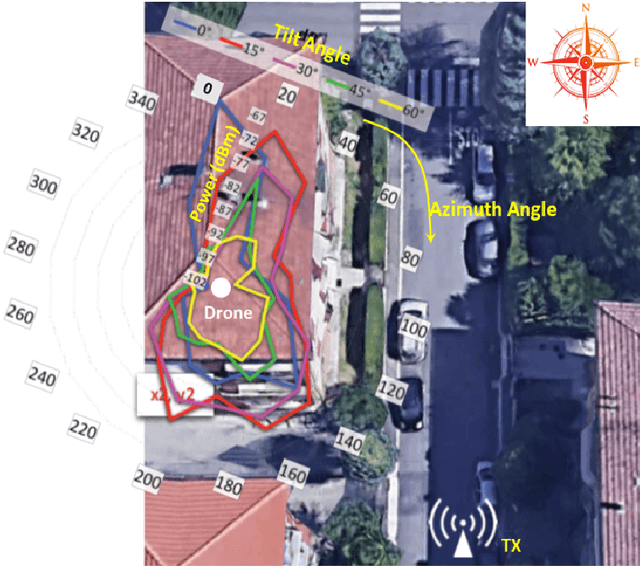
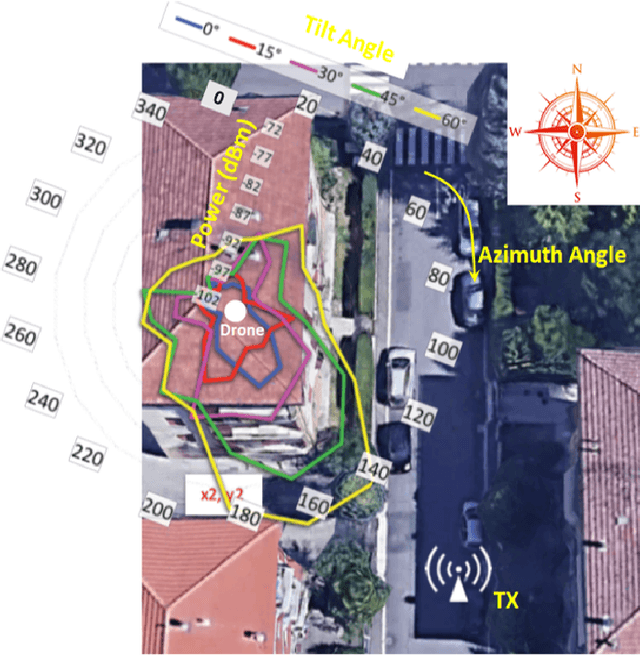
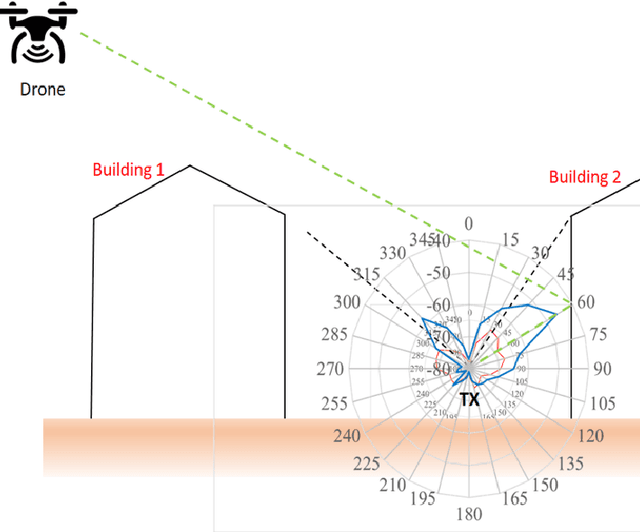
Abstract:In the present study, a measurement setup utilizing mm-wave transceivers with steerable directive antennas, mounted on both a customized UAV and a ground station has been used to study Air-to-Ground (A2G) radio links and, more generally, full-3D mm-wave propagation in urban environment. We evaluate the double-directional characteristics of the channel by rotating the antennas, deriving Power-Angle Profiles at both link ends. Preliminary results provide useful understanding of A2G propagation, e.g. the influence of the antenna tilt angles, or the mechanisms allowing for the signal to propagate from street canyons to the air.
 Add to Chrome
Add to Chrome Add to Firefox
Add to Firefox Add to Edge
Add to Edge